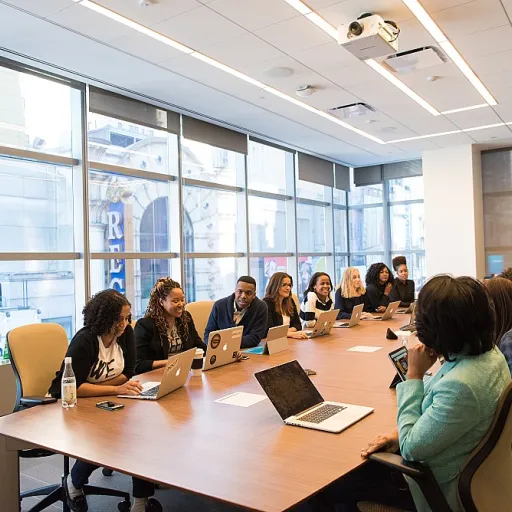
Defining Workplace Services
Introduction to Workplace Services
The term "workplace services" may seem straightforward, but it encompasses a myriad of components that contribute to the smooth functioning of any business. At its core, workplace services refer to the various services and support systems provided within a workplace environment to enhance the employee experience and ensure operational efficiency. Workplace services can range from essential facilities management—like maintaining office spaces, meeting rooms, and managing physical office resources—to innovative digital tools aimed at supporting both remote and hybrid work environments. These services are pivotal in creating a seamless workplace experience, as they ensure employees have access to the necessary tools and resources, whether they are working from the office or remotely.Components of Workplace Services
- Physical Office Services: This includes the traditional aspects such as workspace design, facility management, and maintenance of meeting rooms and office spaces.
- Digital Workplace: Incorporating digital tools that facilitate communication, collaboration, and allow access to business data in real time, enhancing both remote and in-office work experiences.
- Workplace Management: A strategic approach to ensuring all services align with organizational goals, thus improving employee satisfaction and productivity.
The Role of Communication in Workplace Services
Enhancing Collaboration Through Communication
Effective communication is crucial in optimizing workplace services. As environments evolve into digital workplaces, a seamless flow of information enhances the workplace experience and cultivates a more productive employee experience. The connection between management and employees is vital, whether it is in the physical office or through remote work setups.- Facilitating smooth workplace management involves a well-structured communication system that supports both hybrid work and remote work models.
- Companies aim to provide employees with efficient access to necessary resources, maximizing their time and the availability of various office spaces such as meeting rooms.
- Digital tools allow for real-time collaboration and the sharing of data, ensuring that workers are on the same page despite geographical separations.
Challenges in Human Resources Communication
Addressing Human Resources Communication Challenges
In the realm of workplace services, communication holds a central place. However, the road to effective human resources communication is fraught with hurdles. These can range from bridging the gap between remote and physical office workers to ensuring transparency in communication practices. Poor communication strategies can result in decreased employee satisfaction and collaboration, leading to a less effective workplace experience. One of the main challenges is the facilitation of seamless communication in a hybrid work environment. Companies need to ensure that employees have equal access to digital tools, whether they are in an office space or working remotely. Keeping communication clear and effective while managing employee experience and staying aligned with business objectives can be daunting. Moreover, emerging workplace services, such as digital workplaces and real-time data utilization, demand a strategic approach. These services require HR departments to adapt their communication strategies to accommodate new digital tools and platforms that facilitate both remote work and in-office collaboration. This evolution not only involves technology adaptation but also encourages cultural shifts within organizations to maintain happy employees and effective communication. For the effective management of these challenges, companies are increasingly relying on modern workplace services. By fostering a workplace digital strategy, organizations can enhance communication collaboration and improve employee experiences. As new tools continue to emerge, the communication channels need to remain agile to adapt to these innovative services. For further insights into employment-related challenges, consider exploring discussions on employment law violations in Washington, which can also impact workplace communication strategies.Strategies for Effective HR Communication
Enhancing Communication for Better Workplace Services
Effective communication is the backbone of successful workplace services. It ensures that employees are informed, engaged, and satisfied, which in turn boosts productivity and morale. Here are some strategies to enhance communication within the workplace:
- Utilize Digital Tools: In today's digital workplaces, leveraging tools like instant messaging, video conferencing, and collaborative platforms can bridge the gap between remote and in-office employees. These tools facilitate real-time communication, ensuring that everyone has access to the same information, regardless of their location.
- Foster Open Communication Channels: Encourage open dialogue between management and employees. This can be achieved through regular meetings, feedback sessions, and surveys. Open communication helps in understanding employee needs and improving the overall workplace experience.
- Implement a Communication Strategy: A well-defined communication strategy helps in aligning the company's goals with employee expectations. It ensures that the right message is delivered at the right time, enhancing employee satisfaction and engagement.
- Promote a Collaborative Culture: Encourage collaboration among employees by creating spaces, both physical and digital, where they can share ideas and work together. This not only improves communication but also fosters innovation and creativity.
- Provide Training and Development: Equip employees with the necessary skills to use digital tools effectively. Training sessions can help them adapt to new technologies, improving their communication and collaboration capabilities.
By implementing these strategies, companies can create a more cohesive and efficient workplace environment. As businesses continue to adapt to hybrid work models, the importance of effective communication in workplace management cannot be overstated. It's crucial for maintaining a positive employee experience and ensuring that workplace services meet the evolving needs of the workforce.
Technology's Impact on Workplace Services
Leveraging Technology for Streamlined Workplace Services
With the rise of digital tools, the landscape of workplace services has undergone significant transformations. Technology plays an essential role in enhancing both the workplace and employee experience, contributing to more efficient management of office spaces and the hybrid work model.- Digital Workplace Solutions: The integration of digital tools in the workplace has revolutionized how employees collaborate and communicate. These solutions provide seamless access to necessary resources and information, facilitating a shift towards more agile and flexible environments.
- Enhancements in Facility Management: Technology-driven facility management tools allow for real-time monitoring and management of office spaces. This leads to optimized utilization of resources and enhances employee satisfaction by ensuring a comfortable and efficient workplace.
- Remote and Hybrid Work Enablement: As remote work becomes more prevalent, digital workplace tools become crucial in maintaining connectivity and productivity. Tools for video conferencing, project management, and virtual collaboration are essential for supporting distant workers.
- Effective Data Management: Businesses now leverage data analytics to make informed decisions regarding workplace services. By analyzing patterns and trends, companies can tailor their offerings to better suit the needs of their employees.
Future Trends in Workplace Services and HR Communication
Emerging Trends Shaping the Future of Workplace Services
The landscape of workplace services is evolving rapidly, driven by technological advancements and changing employee expectations. As companies strive to enhance the employee experience, several trends are emerging that will shape the future of workplace services and HR communication.
Embracing Hybrid Work Models
The shift towards hybrid work models is becoming more prevalent as businesses recognize the benefits of flexibility. This approach combines remote work with traditional office space, allowing employees to choose where they work best. Effective workplace management will require HR to facilitate seamless communication and collaboration between remote and in-office teams, ensuring that all employees have access to the necessary digital tools and resources.
Leveraging Digital Workplaces
The rise of digital workplaces is transforming how employees interact with their work environment. By integrating advanced digital tools and platforms, companies can enhance employee satisfaction and productivity. Real-time data analytics and workplace digital solutions will enable HR to tailor services to meet the unique needs of their workforce, fostering a more personalized and efficient workplace experience.
Focus on Employee Well-being
As the lines between work and personal life blur, companies are placing a greater emphasis on employee well-being. This includes creating a supportive work environment that promotes mental health and work-life balance. HR communication strategies will need to prioritize transparency and empathy, ensuring that employees feel valued and supported in their roles.
Enhancing Facility Management with Technology
Advancements in facility management technology are enabling businesses to optimize their office space and resources. From smart meeting rooms to automated systems, these innovations are streamlining operations and enhancing the overall workplace experience. HR professionals will need to stay informed about these developments to effectively manage and communicate changes within the organization.
Data-Driven Decision Making
Data is becoming a crucial component of workplace services, providing insights into employee behavior and preferences. By leveraging data analytics, HR can make informed decisions that improve employee satisfaction and drive business success. This data-driven approach will require HR to develop new skills and strategies to interpret and act on the information effectively.












